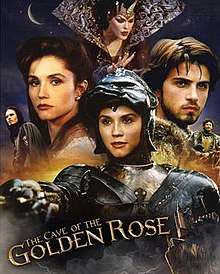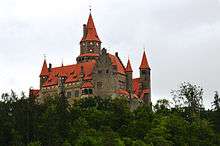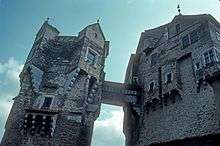Fantaghirò series
Fantaghirò, alternately titled The Cave of the Golden Rose (La Grotta della Rosa d'Oro), is an Italian fantasy series consisting of five television films directed by Lamberto Bava and released between 1991 and 1996. The first film was originally based on Italo Calvino's Fanta-Ghiro the Beautiful, before splitting in its own direction in the sequels, and takes place in a fairy tale setting, featuring princesses, princes, witches, wizards and talking animals. Highly popular in Italy during the 1990s, it was loosely adapted into a cartoon series of the same title and there also have been abortive plans for further film entries.
| Fantaghirò | |
|---|---|
 | |
| Directed by | Lamberto Bava |
| Produced by | Roberto Bessi |
| Written by | Gianni Romoli |
| Starring | Alessandra Martines Kim Rossi Stuart Brigitte Nielsen |
| Music by | Amedeo Minghi |
Release date | 1991—1996 |
| Country | Italy |
| Language | Italian |
Films
Fantaghirò (1991)
Fantaghirò is the youngest of three princesses born to a warrior King. Although beautiful and intelligent, she causes many problems for her family because she goes against everything expected for a woman in her kingdom, by being literate, adventurous and rebellious, which makes her father furious. One day, the warrior King receives an invitation from the enemy king Romualdo to a duel that can potentially end the centuries-long war that has been going on between the two kingdoms. The warrior king then learns that only one of his three daughters can win the fight. Fantaghirò sees this as a chance for her to prove herself.
Fantaghirò 2 (1992)
Fantaghirò and Romualdo are due to be married, but their wedding is cut short when news arrives that Fantaghirò's father has been kidnapped by the evil Black Witch. The witch demands that Fantaghirò and Romualdo submit to her rule, but they refuse and Romualdo declares war. He sets out with his army, leaving behind Fantaghirò, who has sworn not to lift another weapon for the rest of her life. However, Fantaghirò finds that she has to break her promise, and secretly sets out on her own to the Dark Kingdom, where the witch will do everything in her power to separate Fantaghirò from Romualdo forever and make him her lover.
Fantaghirò 3 (1993)
The dark wizard Tarabas learns that his powerful kingdom will be defeated by a royal child of no more than ten years of age. He becomes obsessed with learning how this will happen, so he orders his clay warriors to kidnap all of the world's royal children. When the children of Fantaghirò's sisters become targets, Fantaghirò and Romualdo protect them from the attacking clay soldiers. However, during the fight Romualdo accidentally falls into a cursed river and turns into stone. Fantaghirò then learns that she has to find Tarabas if she wants to save her beloved Romualdo.
Fantaghirò 4 (1994)
A black cloud is travelling throughout the land, destroying everything it touches. When the black cloud consumes Fantaghirò's castle, she allies herself with Prince Parsel to track the black cloud to its origins and stop whoever is casting it. Along the way, Fantaghirò is reunited with the wizard Tarabas, who agrees to help them on their quest, and Princess Anjelica, who is in love with Tarabas.
Fantaghirò 5 (1996)
Fantaghirò is captured by the Black Witch, who has been unable to perform evil magic ever since she helped Fantaghirò in the previous films. The witch is about to decapitate Fantaghirò when she is suddenly sucked into an alternate reality where she has to join forces with a scoundrel named Aries in defeating a villain who eats children.
Cancelled sequels
The producers planned a further continuation of the series, which would have included two more chapters (sixth and seventh). In these, Fantaghirò would have continue to travel to parallel worlds, including ours, before returning home to find it too an alternative reality where she would face an evil version of herself.[1][2][3] Another sequel, Il ritorno di Fantaghirò (The Return of Fantaghirò), was considered by Lamberto Bava and Gianni Romoli in 2007.[4]
Main characters
Fantaghirò

Fantaghirò, portrayed by Alessandra Martines, is the main character of all five films. The youngest princess of three, she is outspoken, headstrong and never retreats from battle. In the first film, she is an impulsive troublemaker who likes to provoke her father and sisters, but underneath it she has a good heart. By the second film onwards, she is accepted as a fighter who will do whatever it takes to protect her loved ones, even if that means sacrificing her own life. She is deeply in love with Romualdo, who was previously her kingdom's enemy. They are married in the third film and adopt the orphaned Princess Esmeralda as their daughter.
The Fantaghirò has long red-brown hair which she cuts into a boy-cut in the first and second film, but in the third film onwards she only has the boy-cut. Fantaghirò tries to befriend all creatures and people she meets, unless they try to harm those she cares about. She is very forgiving and looks past physical appearances. The role launched Martines' career.[5]
Romualdo

Romualdo, portrayed by Kim Rossi Stuart, is Fantaghirò's beloved and later husband. After the death of his father, Romualdo seeks to end the centuries-long war his ancestors have waged against Fantaghirò's people by challenging Fantaghirò's father to single combat. He falls in love with her in the first film and becomes obsessed with finding her. He is shocked when he meets her properly for the first time, as she has chosen to replace her father as Romualdo's opponent, and is disguised as a man. Eventually he learns that she is a princess and the two are bethrothed. They are due to be married early in the second film, but the ceremony is postponed when the Black Witch kidnaps Fantaghirò's father. Romualdo becomes the Black Witch's target, and she bewitches him to make him her lover. Romualdo eventually regains his memories thanks to Fantaghirò and the White Witch.
In the third film, Romualdo turns into a statue whilst fighting Tarabas' men, and is only revived near the end of the movie, when the pair are finally married. In the fourth film, Stuart did not want to return again for the role,[5] so Romualdo was transformed into the hideously ugly Fiodor, portrayed by Riccardo Serventi Longhi. At the end of the film, Fiodor is transformed back to Romualdo. Romualdo does not appear at all in the fifth film, except in flashback.
The Black Witch
The Black Witch (Strega Nera), also known as the Black Queen (Regina Nera), portrayed by Brigitte Nielsen (original Italian dubbing by Aurora Cancian), is the evil counterpart of the White Witch, who first appears in the second film and wants to destroy Fantaghirò and Romualdo's romantic relationship as she obsessively hates their pure love and desires the handsome prince for herself. The witch lures them to her kingdom by kidnapping Fantaghirò's father, casts a spell on Romualdo to make him fall in lustful love with her, and plots to kill Fantaghirò. Eventually, Fantaghirò manages to defeat her rival, as the Black Witch is turned to stone and smashed, and then her vengeful remnant inside Romualdo's mind is eradicated by the White Witch.
However, her beloved character became so popular that the director decided to revive her even in the next three chapters of the saga.[5][6] In the third film, her former minions, Bolt and Lightning, decide to resurrect her because Fantaghirò needs her help against Tarabas. Because the Black Witch does help Fantaghirò, albeit reluctantly, her evil powers are weakened. In the fourth and fifth films she constantly tries to get back at Fantaghirò so she can be powerful again. She has remained a beloved fan-favorite.[7]
Tarabas
Tarabas, portrayed by Nicholas Rogers (original Italian dubbing by Francesco Prando), is a wizard who appears in the third and fourth films. He is initially a very powerful villain who is feared by magicians in every kingdom, but he discovers a prophecy that a royal child no older than ten years will defeat him. Tarabas becomes obsessed with learning how he will be defeated, and sends his men to kidnap all royal children, during which the parents of young Princess Esmeralda are killed. He crosses paths with Fantaghirò and falls in love with her, eventually asking her to marry him in exchange for reviving Romualdo, who has been turned into stone.
In the end, Tarabas lets Fantaghirò free from her promise and the two kiss once before Fantaghirò returns to her true love. He redeems himself with Esmeralda by allowing her to see her parents one last time, an act of kindness which fulfills the prophecy of his dark powers' downfall. Tarabas renounces his evil ways and lives in peace until the fourth film, when he is accused of creating a destructive black cloud consuming all in its path. Tarabas reunites with Fantaghirò to track down the source of the black cloud and discovers that it was conjured by his father, Darken. At the end of the fourth film, Tarabas decides to renounce his love for Fantaghirò and stay with Princess Angelica of Tohor.
Other characters
- Angelica, portrayed by Agathe de La Fontaine, is the princess of the oriental kingdom of Tohor. She has listened to stories of Tarabas from when he was a dark wizard, and has adored him. When she learns that Tarabas is in her kingdom, she finds him and declares her love for him. Tarabas rebuffs her affections throughout the entire movie until the very end, when he promises to try to love her.
- Bolt (Saetta), portrayed by Lenca Kubalkova, is a magical sprite and sister of Lightning. Introduced in the second film, she is originally a slave cminion of the Black Witch, but Bolt betrays her and joins the side of good with Fantaghirò. In the third film, Bolt says that she and her brother are training to be angels. She can transform into a bolt of lightning and fly in the air. She hates water, and cannot fly if she falls in a river.
- Caroline (Carolina), portrayed by Kateřina Brožová, is one of the Fantaghirò's sisters. She has golden hair, is a hopeless romantic and is well aware of her beauty, traits that usually infuriate Fantaghirò. In the first film she marries Ivaldo, she is pregnant in the second film, and by the third film she has a son. She can briefly be seen in the fourth film, but only at distance, and her face cannot be seen clearly.
- Catherine (Caterina), portrayed by Ornella Marcucci in the first film and Barbora Kodetová in the second and third films, is the eldest sister of Fantaghirò. She is level-headed, wise and patient. She marries Cataldo in the first film, is pregnant in the second film, and has a son in the third film. She has a non-speaking role in the fourth film when their castle is shrunk to the size of a toy, but her face cannot be seen clearly.
- Darken, portrayed by Horst Buchholz, is a cruel wizard so powerful that it is forbidden to speak his name. Aside from being the source of all evil in Fantaghirò's world, he is the father of Tarabas, and wants his son to be just as evil as he is. He appears in the fourth film as the main villain who creates a black cloud that causes destruction wherever it goes. He is powerful enough to revive the dead with a kiss, and wields a sword forged from the blood of giants.
- Esmeralda (Smeralda), portrayed by Elena D'Ippolito, is a young princess seen in the third film. Her parents are killed when Tarabas' clay soldiers attack under his command to kidnap all the royal children of the world. Fantaghirò takes Esmeralda under her care and eventually adopts her. Esmeralda is playful and headstrong, much like Fantaghirò was in her youth.
- Goldeye (Occhio d'Oro), portrayed by Karel Roden, is a minor villain in the second film. He is a bandit who robs anyone he comes across. Fantaghirò humiliates him at the beginning of the film by beating him in armed combat. Later their paths cross again and Goldeye tries to get his revenge by making Fantaghirò dress up as a belly dancer.
- The King, portrayed by Mario Adorf, is Fantaghirò's father and appears in the first two films. He is initially disappointed by Fantaghirò's birth, as he had been expecting a son, who would become his heir. His disappointment worsens when she grows up refusing to be meek and obedient as all women in his kingdom are expected to be. However, he grows to care for Fantaghirò over the first film and accepts her as she is. In the second film, he is kidnapped by the Black Witch and is magically hypnotised into becoming the Dark King.
- Lightning (Fulmine), portrayed by Jakub Zdeněk, is a magical sprite and older brother of Bolt. He starts to rebel against his mistress, the Black Witch, early in the second film, and it is he who instigates Bolt to do the same. In the third film, he and Bolt put all the stone pieces of the Black Witch back together to revive her, but Lightning keeps the witch's heart as leverage.
- Cataldo, portrayed by Stefano Davanzati, is one of Romualdo's closest friends. He appears in the first and second films as Romualdo's companion. He's the one who comes up with the idea of holding a swimming competition to reveal Fantaghirò's true gender in the first film. He later falls in love with and marries Catherine.
- Ivaldo, portrayed by Tomáš Valík, is one of the Romualdo's closest friends and appears in the first and second films. He later falls in love with and marries Caroline.
- Nameless (Senza Nome), portrayed by Remo Girone, is the villain of the fifth film. He is an ogre made of enchanted apalicandro wood, which renders him invulnerable to almost all attacks. Animated with the magic of a hundred witches, Nameless was created in order to end a centuries-long war of attrition, only to rebel against his creators. He travels through different worlds on a flying galleon in order to become more human by feeding on children. His presence alone is enough to transform food items into deadly monsters.
- The Queen of the Elves (Regina Degli Elfi), portrayed by Aňa Geislerová, is the Queen of the Forest Elves. She is beautiful and wears a gown of red and gold leaves. In the second film she stops Romualdo and his army who are on the way to the Dark Kingdom. She gives Romualdo three tests to prove his worth, which he succeeds. In the third film, she is visited by Fantaghirò, who needs help in breaking a curse that has turned Romualdo into the stone. The Queen of the Elves tells Fantaghirò that the wizard she seeks is Tarabas.
- The White Witch (Strega Bianca), portrayed by Ángela Molina in the first film and Katarína Kolajová in the second film, is a good witch and friend of Fantaghirò. She has been instrumental in protecting and guiding Fantaghirò ever since she was a baby, although the princess is not always aware of the White Witch's involvement. The White Witch can transform into various animals, including a goose, a mouse and a cat. She also transformed into the White Knight in order to train Fantaghirò in the art of swordsmanship. In the second film, the White Witch renounces her powers in order to free Fantaghirò from a magical promise she had made. Although she does not appear in the later films, early in the third film it is mentioned that she has retired to the country.
- Xellesia, portrayed by Ursula Andress, is an evil witch and the mother of Tarabas. She is conniving, wicked, and tries her best to keep her son away from all things good and warm. She appears in the third and fourth films. By the end of the third film, the reformed Tarabas tires of his mother's evil ways and robs her of her powers. In the fourth film, she confesses that she has always loved Tarabas but has had to keep her love hidden from him. She proves this by sacrificing herself so that Tarabas can escape to safety.
Production and release history
The series' premise is based on Italo Calvino's Fanta-Ghiro the Beautiful.[1] Director Lamberto Bava said the films were influenced by Legend, Ladyhawke and Willow,[9] as well as by Disney animated movies and the 1950s fantasy cinema.[10] Initially Fantaghirò was to be a single film but the production costs were excessive and so it was decided to make it as a miniseries.[3] Fantaghiro was produced by Rete Italia and filmed mostly in the former Czechoslovakia; the last two films were shot Thailand and Cuba.[1] The musical score, including the theme song "Mio nemico" ("My Enemy"), was written by Amedeo Minghi and performed by Rossana Casale.[11]
Kim Rossi Stuart, who has auditioned for the part of Romualdo at the age of 22, after only two films in the TV series already decided to not want to play his character anymore (his appearance in the fourth film is just with stock footage from the first film) and for this reason every sequel in the series has been developed based on the choices of the actors to stay or leave the cast.[1] Brigitte Nielsen said she based her deliberately over-the-top role on the character of the Evil Queen in Disney's Snow White;[12] her role as the Black Witch was received so well by the public that Bava decided to revive the character for three successive chapters of the saga.[1][13] The character Tarabas was born from the writer Gianni Romo's passion for the comic book series Dylan Dog, where a character of this name appears in one story.[3]
The series has been shown in more than 50 countries[14] and was dubbed in several languages, Bulgarian, Czech, Slovak, English, French, Polish, German, Spanish, Hungarian, Ukrainian, Russian, Georgian and Sinhala. Martines gained popularity thanks to the success of Fantaghirò and voiced herself in the French version.[1] The first three films were recut (reduced and intersected with each other) into a 200-minute compilation film titled La meravigliosa storia di Fantaghirò ("The Wonderful Story of Fantaghirò") in 1995.[15] Between December 22, 2011 (20 years to the first airing), and January 30, 2012, the saga was aired on Italia 1 as a television series of 40 episodes lasting 20 minutes each.[16] Its new theme song by Amedeo Minghi and Arianna Bergamaschi, Crederò ("I Will Believe") was included on the 2011 compilation soundtrack CD Il Fantastico Mondo di Fantaghirò ("The Fantastic World of Fantaghirò").[17] A restored and remastered edition of the series was released on DVD and Blu-ray in 2016 in Italy, Germany, and France.[18][19][20]
The sixth and seventh films in the series were never realized due to a dramatic decline of audience recorded during the airing of Fantaghirò 5 on Christmas 1996, and so the project was shelved. A proposal for another sequel was again presented to Mediaset by Bava and Romo in 2007, following the continuous pressure of the fans of the series who were disappointed by how the fifth episode ended. Martines, Nielsen and Rogers confirmed their availability, but the project never came to fruition due to difficulties in co-production and the costs being deemed too high for its realization.[13][21]
Legacy
The series' high popularity[22] and cult success during the early 1990s[23][24] led Bava to make a few other television movies in a similar style for Mediaset, including Desideria e l'Anello del Drago (Desideria), La Principessa e il Povero (The Princess and the Pauper) and Sorellina e il Principe del Sogno (Princess Alisea). It also led to the creation of a 1999-2000 Spanish animated television series by BRB Internacional, also titled Fantaghirò and co-written by Bava.[25] A theme restaurant Fantaghiro opened in Rome in 2001.[26][27]
References
- "Fantaghirò: 10 curiosità sul cast e sulla serie tv cult | Televisionando". Televisionando.it. 2015-12-21. Retrieved 2016-01-14.
- Enrica Raia (2014-06-20). "Fantaghirò, tutte le curiosità sulla serie cult - Blog di Cultura". Blogdicultura.it. Retrieved 2016-01-14.
- Maggino, Aurelia (2014-06-20). "Fantaghirò: le 20 curiosità sulla serie tv che non sapevi". Gossipetv.com. Retrieved 2016-01-14.
- "Fantaghirò 6 e 7: i due capitoli mai realizzati". TvSerial (in Italian). 2018-12-19. Retrieved 2019-03-11.
- "Fantaghirò: 10 curiosità sul cast e sulla serie tv cult". Televisionando (in Italian). Retrieved 2019-05-19.
- "Che Natale sarebbe senza Fantaghirò? La saga fantasy torna su Mediaset". www.film.it (in Italian). Retrieved 2019-05-19.
- "5 assurdi motivi per cui amiamo ancora Fantaghirò". Wired (in Italian). 2017-12-21. Retrieved 2019-05-19.
- "FANTAGHIRO' CONTRO LA STREGA - la Repubblica.it". Ricerca.repubblica.it (in Italian). 1992-08-28. Retrieved 2016-01-14.
- Louis Paul, Italian Horror Film Directors.
- "Streghe E Principi Malvagi Contro L' Audace Fantaghiro' - La Repubblica.It" (in Italian). Ricerca.repubblica.it. 1993-08-12. Retrieved 2014-02-17.
- "Torna Fantaghirò: 15 cose da sapere". VanityFair.it. 2015-12-21. Retrieved 2016-01-14.
- "La cattiva: inseguo sempre la TV". Archiviostorico.corriere.it. Retrieved 2014-02-17.
- "Che Natale sarebbe senza Fantaghirò? La saga fantasy torna su Mediaset". Film.it. 2015-12-21. Retrieved 2016-01-14.
- "Fantaghirò (Animation) DVD Cover" (PDF). brb.es. Archived from the original (PDF) on 2012-06-21. Retrieved 2017-04-05.
- "La meravigliosa storia di Fantaghirò (1995)". FilmTV.it. 2015-08-31. Retrieved 2016-01-14.
- "Fantaghiro' Official's Photos - Fantaghiro' Official - Facebook". Retrieved 7 September 2014.
- "Gruppo Mediaset - L'Azienda - Programmi - Il FANTASTICO MONDO DI FANTAGHIRÒ 2011". Mediaset.it. 2015-05-27. Retrieved 2016-01-14.
- von Steffen Kutzner Veröffentlicht. "Wir verlosen eine "Prinzessin Fantaghiro"-Box!". Stadtmagazin.com. Retrieved 2016-01-14.
- "Prinzessin Fantaghiro, die Heldin der 90er ist zurück". Heute.at (in German). Retrieved 2019-05-19.
- Coffineau, Aurélie (2018-03-10). "#LesFilmsDeLaHonte : Il était une fois... La Caverne de la rose d'or". CinéSéries (in French). Retrieved 2019-05-19.
- ""Prinzessin Fantaghiro": Anderes Ende geplant!". TVMovie (in German). 2018-12-22. Retrieved 2019-05-19.
- Laura Delli Colli (1992-04-09). "QUELLI DELLA TV - la Repubblica.it". Ricerca.repubblica.it (in Italian). Retrieved 2016-01-14.
- "Bava: ma l'Italia non crede al genere - la Repubblica.it". Ricerca.repubblica.it (in Italian). 2011-07-25. Retrieved 2016-01-14.
- Archived December 14, 2013, at the Wayback Machine
- "Arriva Fantaghirò una fiaba di cartoon - la Repubblica.it". Ricerca.repubblica.it (in Italian). 2000-10-22. Retrieved 2016-01-14.
- "appuntamenti DI NOTTE". Archiviostorico.corriere.it. Retrieved 2016-01-14.
- "Fantaghirò, Roma - birreria - Roma - Repubblica.it". Roma.repubblica.it (in Italian). Retrieved 2016-01-14.
External links
- Official website (in Italian)
- "Fantaghirò, persona bella" - original fairytale by Italo Calvino (in Italian)
